 Front of locomotive at left | |||||||||||||||||
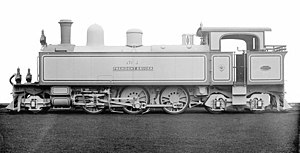 | |||||||||||||||||
| |||||||||||||||||
| |||||||||||||||||
| |||||||||||||||||
Under the Whyte notation for the classification of steam locomotives, a 2-6-4 locomotive has two leading wheels, six coupled driving wheels and four trailing wheels.
 Front of locomotive at left | |||||||||||||||||
 | |||||||||||||||||
| |||||||||||||||||
| |||||||||||||||||
| |||||||||||||||||
Under the Whyte notation for the classification of steam locomotives, a 2-6-4 locomotive has two leading wheels, six coupled driving wheels and four trailing wheels.
With only a few known exceptions, the Adriatic wheel arrangement was usually used on tank locomotives, for which various suffixes to indicate the type of tank would be added to the wheel arrangement, for example 2-6-4T for an engine with side-tanks.
The earliest known example was the South African Class 6Z, designed by Cape Government Railways (CGR) Chief Locomotive Superintendent Hazlitt Beatty in 1901. The first engines of the class were modified 2-6-2 Prairie locomotives which were equipped with two-axle trailing bogies. In 1902, more were placed in service, but built with the 2-6-4 wheel arrangement. The latter were the first known tender locomotives in the world to be built with this wheel arrangement. [1] [2] [3]
Tank engines with the 2-6-4T wheel arrangement were produced for many different railway systems worldwide and were mainly used for freight and suburban passenger working. They have been less successful on express passenger trains. The earliest known example also originated in South Africa, the Pretoria-Pietersburg Railway's 55 Tonner of 1898. [3] [4] [5]

Two Austrian express tender locomotive types were of this wheel arrangement, the 210 class of 1908 and 310 class of 1911 designed by Karl Gölsdorf. The type therefore became known as the Adriatic arrangement, named for the Adriatic Sea which bordered Austria-Hungary.
Preserved meter gauge locomotive Dona Joaninha, built to haul sugar cane in Brazil, uses the 2-6-4 wheel arrangement.

Finland had three locomotive classes with a 2-6-4T wheel arrangement, the Classes Vk1, Vk2 and Vk3. All three classes were nicknamed Iita.
The Class Vk1, numbered 301 to 305, were delivered in 1900 from Baldwin Locomotive Works of Philadelphia, Pennsylvania. The Class Vk1 Iita were also nicknamed Amerikan because they were built in the United States.
The Class Vk2 were numbered 454 to 455.
The Finnish Steam Locomotive Class Vk3 were numbered 456 and 487 to 492. They were built in 1915 by Tampella, a Finnish heavy industry manufacturer, and were used for local passenger duties. One of them, Vk3 No 489, is preserved at the Finnish Railway Museum.

Two Deutsche Bundesbahn (DB) 2-6-4T Class 66 locomotives, designed for fast goods train and passenger train service, were built in 1955 as part of the DB's Neubaulok construction programme. They were both withdrawn from service in 1968. One, DB 66 002, has been preserved at the Bochum-Dahlhausen Railway Museum.

For the private TAG, which operated the railway line from Schaftlach to Tegernsee, the 2-6-4T steam locomotive TAG 8 was built in 1942, using wheels from DRG Class E 79. It was in service until 1970 and has been preserved in the Bavarian Railway Museum.
SJ type SB with driving wheels 1.75 m diameter for passenger use, built Motala 1917, one preserved.
SJ type J with driving wheels 1.3 m diameter for mixed traffic use, built Atlas, Motala and Nohab, 1914–1918. Four preserved.
2-6-4 tank locomotives were built by SLM in 1913 for use on the Berne-Neuenberg railway. They were still in use at Basel in 1956. Of slightly British appearance, at that time they were used to transfer stock between the French and Swiss systems, the former having not yet been electrified.
The Ferrymead Railway in Christchurch, New Zealand has a 3 ft 6 in (1,067 mm) gauge 2-6-4T locomotive that was in regular operation until taken off-line for boiler repairs around 2009. It was built by Baldwin Locomotive Works in 1901. [6]
The Wf class of the New Zealand Government Railways was built between 1903 and 1928 and was a general purpose tank design. It was used all over New Zealand and identical locomotives were also in service as the Ds class of the Tasmanian Government Railways. Three Wf class locomotives survived in preservation:

Between 1898 and 1900, the Pretoria-Pietersburg Railway (PPR) placed six 2-6-4T locomotives in service, built by Beyer, Peacock & Company. During the Second Boer War, they were first taken over by the Nederlandsche-Zuid-Afrikaansche Spoorwegmaatschappij (NZASM) and then by the Imperial Military Railways (IMR). After the war, they were taken onto the roster of the Central South African Railways (CSAR) and in 1912 they were assimilated into the South African Railways (SAR) as Class D. [3] [4] [5] [7]
In 1901, the CGR placed four 6th Class 2-6-2 Prairie tender steam locomotives in service, designed at the Salt River works of the CGR and built by Neilson, Reid & Company. During trials, it was found that they were inclined to be unsteady at speed and the locomotive design was therefore modified to a 2-6-4 wheel arrangement by replacing the trailing carrier wheels with a two-axle bogie. Another four locomotives incorporating this modification were ordered later in 1901 and delivered in 1902, the first tender locomotives in the world to be built with this wheel arrangement. The change in design resulted in a marked improvement in the locomotive's stability at speed and the first four locomotives were therefore also modified accordingly. In 1912, when they were assimilated into the SAR, these eight locomotives were all designated Class 6Z. [1] [2] [3] [5] [7]
In 1902, the CGR placed two Type A Adriatic narrow gauge locomotive in construction service on the Avontuur branch, which was being built out of Port Elizabeth through the Langkloof. They were built by Manning Wardle and, at a width of 7 feet 9 inches (2.362 metres), they were the widest locomotives to see service on any of the 2 feet (610 millimetres) narrow gauge lines in South Africa. [5]
The first British examples of the 2-6-4T wheel arrangement were two locomotives built for the narrow-gauge Leek & Manifold Valley Light Railway in 1904. The first 4 ft 8+1⁄2 in (1,435 mm) standard gauge examples were the class 1B of the Great Central Railway, built in 1914. [8]
Richard Maunsell of the South Eastern and Chatham Railway (SECR) designed the K class in 1914 for express passenger duties, and in 1925 introduced a three-cylinder variant K1 class for the Southern Railway. These locomotives proved to be unsteady at speed and, following the Sevenoaks railway accident in 1927, they were rebuilt as 2-6-0 tender locomotives. Maunsell did however use the type more successfully for his W class freight locomotives of 1930.
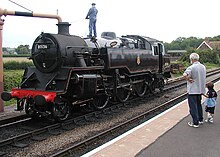
Between 1927 and 1947, the London, Midland and Scottish Railway (LMS) built nearly five hundred 2-6-4Ts for suburban passenger work to four similar designs (see LMS/BR Class 4 2-6-4T locomotives). The last of these, the LMS Fairburn, continued to be built by British Railways (BR) until 1951. Fairburn's LMS design also formed the basis of the very successful BR Standard Class 4, which continued to be produced until 1957.

Between 1946 and 1950, George Ivatt of the LMS also built eighteen 5 ft 3 in (1,600 mm) examples of a very similar design at Derby Works, for use in Northern Ireland. These later became the Northern Counties Committee WT class.
A prototype of the London and North Eastern Railway (LNER) L1 class, designed by Edward Thompson, was built in 1945. The remaining 99 members of the class were built under British Railways administration during the period from 1948 to 1950.
| | This section needs expansion. You can help by adding to it. (May 2024) |
The Reading Company used 2-6-4T Adriatics for commuter service.
The Lionel Corporation used the 2-6-4 wheel arrangement in many of its model steam locomotives, including the 2037 used in the infamous pastel-coloured Girls' Train. [9] Their 2-6-4 model was based on the Pennsylvania Railroad’s K4 class pacific, even though this was a 4-6-2 rather than a 2-6-4. [10]

Under the Whyte notation for the classification of steam locomotives, 4-6-2 represents the wheel arrangement of four leading wheels on two axles, six powered and coupled driving wheels on three axles and two trailing wheels on one axle. The 4-6-2 locomotive became almost globally known as a Pacific type after a locomotive built by the Baldwin Locomotive Works in Philadelphia was shipped across the Pacific Ocean to New Zealand.

Under the Whyte notation for the classification of steam locomotives, 0-4-0 represents one of the simplest possible types, that with two axles and four coupled wheels, all of which are driven. The wheels on the earliest four-coupled locomotives were connected by a single gear wheel, but from 1825 the wheels were usually connected with coupling rods to form a single driven set.

0-6-0 is the Whyte notation designation for steam locomotives with a wheel arrangement of no leading wheels, six powered and coupled driving wheels on three axles, and no trailing wheels. Historically, this was the most common wheel arrangement used on both tender and tank locomotives in versions with both inside and outside cylinders.

Under the Whyte notation for the classification of locomotives, 4-6-4 represents the wheel arrangement of four leading wheels, six powered and coupled driving wheels and four trailing wheels. In France where the type was first used, it is known as the Baltic while it became known as the Hudson in most of North America.

4-4-0, in the Whyte notation, denotes a steam locomotive with a wheel arrangement of four leading wheels on two axles, four powered and coupled driving wheels on two axles, and no trailing wheels.

A 4-6-0 steam locomotive, under the Whyte notation for the classification of steam locomotives by wheel arrangement, has four leading wheels on two axles in a leading bogie and six powered and coupled driving wheels on three axles with the absence of trailing wheels.
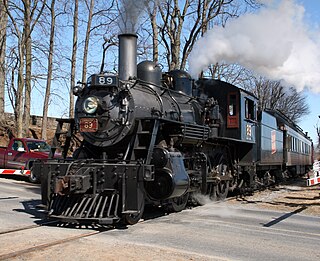
Under the Whyte notation for the classification of steam locomotives, 2-6-0 represents the wheel arrangement of two leading wheels on one axle, usually in a leading truck, six powered and coupled driving wheels on three axles and no trailing wheels. This arrangement is commonly called a Mogul.
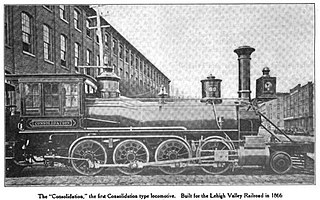
Under the Whyte notation for the classification of steam locomotives, 2-8-0 represents the wheel arrangement of two leading wheels on one axle, usually in a leading truck, eight powered and coupled driving wheels on four axles, and no trailing wheels. In the United States and elsewhere, this wheel arrangement is commonly known as a Consolidation, after the Lehigh and Mahanoy Railroad’s Consolidation, the name of the first 2-8-0.
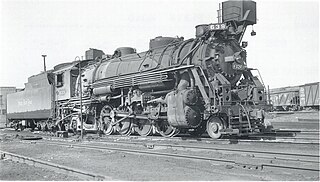
Under the Whyte notation for the classification of steam locomotives, 2-8-2 represents the wheel arrangement of two leading wheels on one axle, usually in a leading truck, eight powered and coupled driving wheels on four axles and two trailing wheels on one axle, usually in a trailing truck. This configuration of steam locomotive is most often referred to as a Mikado, frequently shortened to Mike.

Under the Whyte notation, a 2-8-4 is a steam locomotive that has two unpowered leading wheels, followed by eight coupled and powered driving wheels, and four trailing wheels. This locomotive type is most often referred to as a Berkshire, though the Chesapeake and Ohio Railway used the name Kanawha for their 2-8-4s. In Europe, this wheel arrangement was mostly seen in mainline passenger express locomotives and, in certain countries, in tank locomotives.

Under the Whyte notation for the classification of steam locomotives by wheel arrangement, 4-4-2 represents a configuration of a four-wheeled leading bogie, four powered and coupled driving wheels, and two trailing wheels supporting part of the weight of the boiler and firebox. This allows a larger firebox and boiler than the 4-4-0 configuration.
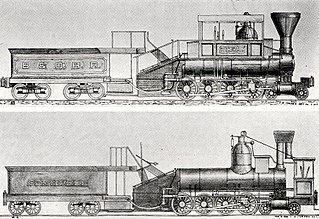
Under the Whyte notation for the classification of steam locomotives, 4-8-0 represents the wheel arrangement of four leading wheels on two axles, usually in a leading truck or bogie, eight powered and coupled driving wheels on four axles and no trailing wheels. In North America and in some other countries the type was usually known as the Twelve-wheeler.
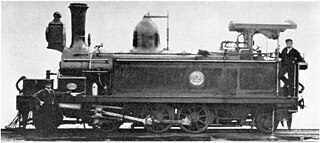
Under the Whyte notation for the classification of steam locomotives, 2-6-2 represents the wheel arrangement of two leading wheels, six coupled driving wheels and two trailing wheels. This arrangement is commonly called a Prairie.
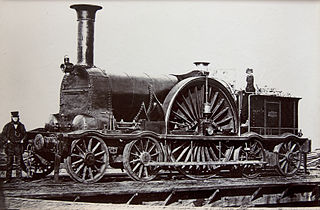
Under the Whyte notation for the classification of steam locomotives, 4-2-4 represents the wheel arrangement of four leading wheels on two axles, two powered driving wheels on one axle, and four trailing wheels on two axles.
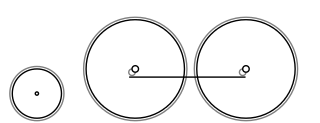
Under the Whyte notation for the classification of steam locomotives, 2-4-0 represents the wheel arrangement of two leading wheels on one axle, four powered and coupled driving wheels on two axles and no trailing wheels. In most of North America it became known as a Porter.

Under the Whyte notation for the classification of steam locomotives, 0-4-2 represents the wheel arrangement with no leading wheels, four powered and coupled driving wheels on two axles and two trailing wheels on one axle. While the first locomotives of this wheel arrangement were tender engines, the configuration was later often used for tank engines, which is noted by adding letter suffixes to the configuration, such as 0-4-2T for a conventional side-tank locomotive, 0-4-2ST for a saddle-tank locomotive, 0-4-2WT for a well-tank locomotive and 0-4-2RT for a rack-equipped tank locomotive.

Under the Whyte notation for the classification of steam locomotives, 0-4-4 represents the wheel arrangement of no leading wheels, four powered and coupled driving wheels on two axles, and four trailing wheels on two axles. This type was only used for tank locomotives.

Under the Whyte notation for the classification of steam locomotives, 0-6-4 represents the wheel arrangement of no leading wheels, six powered and coupled driving wheels on three axles, and four trailing wheels on two axles.

The South African Railways Class 6Z 2-6-4 of 1901 was a steam locomotive from the pre-Union era in the Cape of Good Hope.

The Cape Government Railways 4th Class 4-6-0TT of 1884 was a South African steam locomotive from the pre-Union era in the Cape of Good Hope.